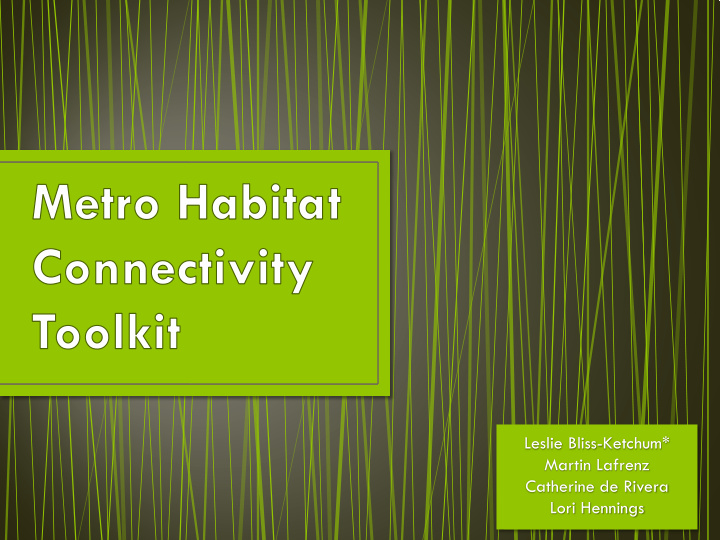



Leslie Bliss-Ketchum* Martin Lafrenz Catherine de Rivera Lori Hennings
Habitat Connectivity • Critical to maintain viable populations of plants and animals • Increasingly important in the face of: • Urban growth and human development • Climate change pressures
• Goal to provide connectivity assessment on an Actionable Scale • Providing detailed empirically derived information to help support decision-making for transportation planning and habitat management • Species specific challenges • Connectivity requirements vary greatly across taxa • Large scale & rapid changes • Inaccuracies of GIS layers compared to ground conditions • Rapid changes on the ground vs date when layers were created
We selected species: • Closely associated with a given habitat type • Neither very rare or overly common • Highlight a range of mobility types • Consideration for susceptibility to barriers The primary focus is on species’ needs and ability to move among patches to access quality habitat areas
• 500m maximum connectivity zone assessment areas • Comparing recent aerial photos • On-the-ground habitat and permeability (barrier) assessments • Verifying GIS assumptions & collecting data not available in layers • Risk of development/prioritization of connectivity zones • identify private vs public ownership as well as zoning • Proximity to UGB
Identify connectivity zone of interest Use GIS to identify the distribution of habitat and landscape scale parameters not easily detected on the ground Use recent aerial photos to determine how many assessment locations are needed and if there are obvious features that should be described in more detail during field assessment In field habitat & permeability assessments Run post processing to determine connectivity score for surrogate species
• Features to be assessed • Roads/Railroads/Trails (GIS sourced when possible, field verified) • Culverts/Bridges (GIS sourced when possible, field verified) • Fences (GIS sourced when possible, field verified) • Wildlife Observations (sign, tracks, song, etc.) • Human Disturbance (unauthorized trails, transient camps, domestic animals, etc.) • Recommendations to improve permeability
• Connectivity patch and matrix characteristics (GIS sourced, field verified) • Water Source (Partially GIS sourced, field verified) • Vegetation (Partially GIS sourced, field verified) • Structural components (field only: snags, rock piles etc.) • Wildlife Observations (field only: sign, tracks, song, etc.) • Human Disturbance (field only: unauthorized trails, domestic animals, etc.)
• Utilize surrogate species specific needs to apply post assessment scoring • However if new species of interest/surrogates are utilized in the future, data from previous assessments should be sufficiently detailed as to be useful for new species assessment and scoring
Apply species-specific requirements to field assessment results: Douglas’ Squirrel American Beaver Red-legged Frog Permeability Habitat Permeability Habitat Permeability Habitat HCZ 1 11% 84% 65% 48% 75% 34% HCZ 2 22% 73% 24% 75% 28% 67% HCZ n..
1 2 DOUGLAS’ SQUIRREL Habitat Permeability 3 4 5 75 11 22 29 33 84 73 68 54 51 SITE 1 SITE 2 SITE 3 SITE 4 SITE 5
• June 2017 • Scoring system and peer review of scoring • July 2017 - June 2018 • Testing new area/habitats and suite of surrogate species • User guide • Ongoing: Exploring funding options for GPS tagging
Recommend
More recommend